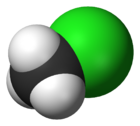Chloromethane
| |||
| Names | |||
|---|---|---|---|
| IUPAC name
Chloromethane
| |||
| Other names
Monochloromethane, Methyl chloride, Artic, Freon 40, R 40, UN 1063
| |||
| Identifiers | |||
3D model (JSmol)
|
|||
| ChEBI | |||
| ECHA InfoCard | 100.000.744 | ||
| EC Number |
| ||
PubChem CID
|
|||
| RTECS number |
| ||
CompTox Dashboard (EPA)
|
|||
| |||
| |||
| Properties | |||
| CH3Cl | |||
| Molar mass | 50.49 g/mol | ||
| Appearance | Colorless gas with a faint sweet odor | ||
| Density | 2.22 kg/m3 (0 °C) | ||
| Melting point | −97.7 °C (176 K) | ||
| Boiling point | -24.2 °C (249 K) | ||
| 5.325 g/l | |||
| log P | 0.91 | ||
| Vapor pressure | 490 kPa (20 °C) | ||
| Structure | |||
| Tetrahedral | |||
| Hazards | |||
| NFPA 704 (fire diamond) | |||
| Flash point | -46 °C | ||
| Supplementary data page | |||
| Chloromethane (data page) | |||
Except where otherwise noted, data are given for materials in their standard state (at 25 °C [77 °F], 100 kPa).
| |||
Chloromethane, also called Methyl chloride, R-40 or HCC 40, is a chemical compound of the group of organic compounds called haloalkanes. It was once widely used as a refrigerant. It is a colorless extremely flammable gas with a minorly sweet odor, which is, however, detected at possibly toxic levels. Due to concerns about its toxicity, it is no longer present in consumer products. Chloromethane was first synthesized by the French chemists Jean-Baptiste Dumas and Eugene Peligot in 1835 by boiling a mixture of methanol, sulfuric acid, and sodium chloride. This method is similar to that used today.
Production
Large amounts of chloromethane are produced naturally in the oceans by the action of sunlight on biomass and chlorine in sea foam. However, all chloromethane that is used in industry is produced synthetically.
Most chloromethane is prepared by reacting methanol with hydrogen chloride, according to the chemical equation
This can be carried out either by bubbling hydrogen chloride gas through boiling methanol with or without a zinc chloride catalyst, or by passing combined methanol and hydrogen chloride vapors over an alumina catalyst at 350 °C.
A smaller amount of chloromethane is produced by heating a mixture of methane and chlorine to over 400 °C. However, this method also results in more highly chlorinated compounds such as methylene chloride and chloroform and is usually only used when these other products are also desired.
Further reaction of chloromethane with hydrochloric acid can produce dichloromethane, trichloromethane (known as chloroform) and tetrachloromethane (also known as carbon tetrachloride).
Uses
Chloromethane was a widely-used refrigerant, but its use has been discontinued due to its toxicity and flammability. Chloromethane was also once used for producing lead-based gasoline additives, but leaded gasoline has been phased out in most of the industrialized world (an important exception being the former Soviet Union).
The most important use of chloromethane today is as a chemical intermediate in the production of silicone polymers. Smaller quantities are used as a solvent in the manufacture of butyl rubber and in petroleum refining.
Chloromethane is employed as a methylating and chlorinating agent in organic chemistry. It is also used in a variety of other fields: as an extractant for greases, oils and resins, as a propellant and blowing agent in polystyrene foam production, as a local anesthetic, as an intermediate in drug manufacturing, as a catalyst carrier in low-temperature polymerization, as a fluid for thermometric and thermostatic equipment, and as a herbicide.
Safety
Inhalation of chloromethane gas produces central nervous system effects similar to intoxication. Victims may feel drowsy, dizzy, or confused and have difficulty breathing, with gasping and choking, walking or speaking. At higher concentrations, paralysis, seizures, and coma may result.
In case of ingestion nausea and vomiting may result. Skin contact when in the form of a refrigerated liquid may result in frostbite. Contact with eyes may result in dim vision, widely dilated pupils that react slowly to changes in light.
Chronic exposure to chloromethane has been linked to birth defects in mice. In humans, exposure to chloromethane during pregnancy may cause the fetus' lower spinal column, pelvis, and legs to form incorrectly, but this has not been conclusively demonstrated.
In 1997, a re-investigation of Boston's Cocoanut Grove nightclub fire cited a chloromethane leak from a refrigerator as a major cause of that disaster.
External links
- International Chemical Safety Card 0419
- NIOSH Pocket Guide to Chemical Hazards. "#0403". National Institute for Occupational Safety and Health (NIOSH).
- MSDS at Oxford University
- Data sheet at inchem.org
- Toxicological information
- Information about chloromethane
- Concise International Chemical Assessment Document 28 on chloromethane
- IARC Summaries & Evaluations Vol. 71 (1999)



